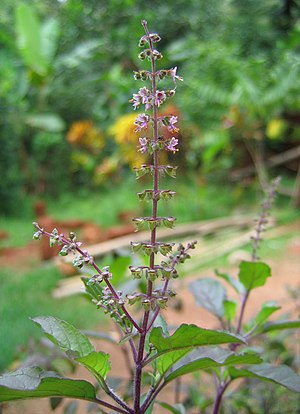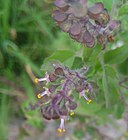Note: This is a project under development. The articles on this wiki are just being initiated and broadly incomplete. You can Help creating new pages.
Ocimum tenuiflorum - Tulsi plant
Tulsi is a scared plant in Hindu belief. Hindus regarding it as an earthy manifestation of the goddess Tulsi, she is regarded as a great worshipper of the god Vishnu. The plant is cultivated for religious and medical purposes, and for its essential oil.
Contents
- 1 Uses
- 2 Parts Used
- 3 Chemical Composition
- 4 Common names
- 5 Properties
- 6 Habit
- 7 Identification
- 8 List of Ayurvedic medicine in which the herb is used
- 9 Where to get the saplings
- 10 Mode of Propagation
- 11 How to plant/cultivate
- 12 Commonly seen growing in areas
- 13 Photo Gallery
- 14 References
- 15 External Links
Uses
Fever, Common cold, Sore throat, Headache, Eye problems, Dental problem, Skin disorder, Insect bites, Kidney stone.
Parts Used
Chemical Composition
Carvacrol, caryophyllene, eugenol, linalool, urosolic acid[1]
Common names
| Language | Common name |
|---|---|
| Kannada | Tulasi |
| Hindi | Tulsi |
| Malayalam | |
| Tamil | Tolasi |
| Telugu | Tulasi |
| Marathi | NA |
| Gujarathi | NA |
| Punjabi | NA |
| Kashmiri | NA |
| Sanskrit | |
| English | Holy Basil |
Properties
Reference: Dravya - Substance, Rasa - Taste, Guna - Qualities, Veerya - Potency, Vipaka - Post-digesion effect, Karma - Pharmacological activity, Prabhava - Therepeutics.
Dravya
Rasa
Tikta (Bitter), Kashaya (Astringent)
Guna
Laghu (Light), Ruksha (Dry), Tikshna (Sharp)
Veerya
Ushna (Hot)
Vipaka
Katu (Pungent)
Karma
Kapha, Vata
Prabhava
Habit
Identification
Leaf
| Kind | Shape | Feature |
|---|---|---|
| Simple | Opposite | Leaves 1.3- 3 x 0.6-2 cm, elliptic-oblanceolate, obtuse at both ends, margin coarsely serrate, puberulous; petiole to 2 cm long, covered with reddish-purple hairs |
Flower
| Type | Size | Color and composition | Stamen | More information |
|---|---|---|---|---|
| Bisexual | Raceme | pink/white | 4 | Racemes to 11 cm long, generally simple, occasionally branched at base; pedicel c. 2 mm long. Bracts to 2 x 3 mm, suborbicular. Calyx purplish, c. 3 mm long, campanulate; lobes 5, upper lip ovate, acute, lower lip hispid without. Corolla reddish-pink, to 4 mm long, tubular-campanulate; tube c. 2 mm long, dotted with sessile oil glands; lobes of upper lip oblong-orbicular; lower lip ovate-oblong. Stamens 4; filaments villous at the base of upper pair. |
Fruit
| Type | Size | Mass | Appearance | Seeds | More information |
|---|---|---|---|---|---|
| Nutlet | 1.5 mm long | ellipsoid, dark brown. | {{{6}}} |
Other features
List of Ayurvedic medicine in which the herb is used
Where to get the saplings
Mode of Propagation
How to plant/cultivate
A plant of the moist to wet, lowland tropics, where it is found at elevations up to 1,000 metres[4]
Commonly seen growing in areas
Tropical area, Subtropical area, Warm fields.
Photo Gallery
References
External Links
- Ayurvedic Herbs known to be helpful to treat Fever
- Ayurvedic Herbs known to be helpful to treat Common cold
- Ayurvedic Herbs known to be helpful to treat Sore throat
- Ayurvedic Herbs known to be helpful to treat Headache
- Ayurvedic Herbs known to be helpful to treat Eye problems
- Ayurvedic Herbs known to be helpful to treat Dental problem
- Ayurvedic Herbs known to be helpful to treat Skin disorder
- Ayurvedic Herbs known to be helpful to treat Insect bites
- Ayurvedic Herbs known to be helpful to treat Kidney stone
- Herbs with Flowers used in medicine
- Herbs with Leaves used in medicine
- Herbs with common name in Kannada
- Herbs with common name in Hindi
- Herbs with common name in Tamil
- Herbs with common name in Telugu
- Herbs with common name in English
- Habit - Herb
- Index of Plants which can be propagated by Seeds
- Index of Plants which can be propagated by Cuttings
- Herbs that are commonly seen in the region of Tropical area
- Herbs that are commonly seen in the region of Subtropical area
- Herbs that are commonly seen in the region of Warm fields
- Herbs
- Ayurvedic herbs that don't have seed photos
- Lamiaceae



